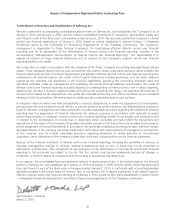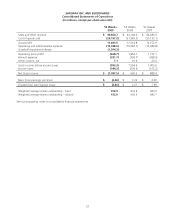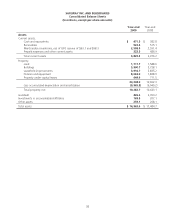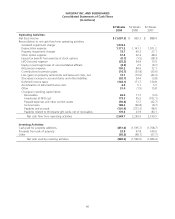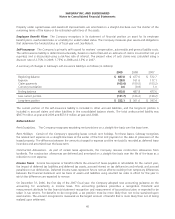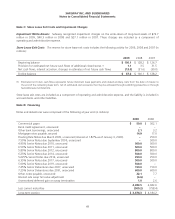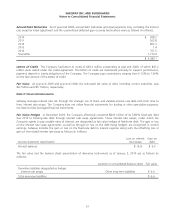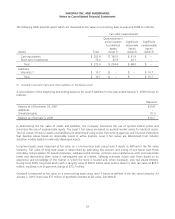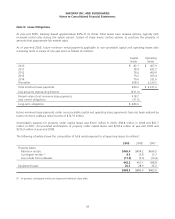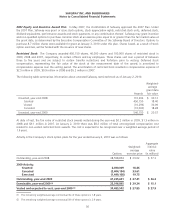Safeway 2009 Annual Report Download - page 64
Download and view the complete annual report
Please find page 64 of the 2009 Safeway annual report below. You can navigate through the pages in the report by either clicking on the pages listed below, or by using the keyword search tool below to find specific information within the annual report.SAFEWAY INC. AND SUBSIDIARIES
Notes to Consolidated Financial Statements
The Company is subject to periodic audits by the Internal Revenue Service and other foreign, state and local taxing
authorities. These audits may challenge certain of the Company’s tax positions such as the timing and amount of income
and deductions and the allocation of taxable income to various tax jurisdictions. The Company evaluates its tax positions
and establishes liabilities in accordance with the applicable accounting guidance on uncertainty in income taxes. These tax
uncertainties are reviewed as facts and circumstances change and are adjusted accordingly. This requires significant
management judgment in estimating final outcomes. Actual results could materially differ from these estimates and could
significantly affect the Company’s effective tax rate and cash flows in future years.
Financial Instruments
Interest rate swaps. The Company has, from time to time, entered into interest rate swap agreements to change its
portfolio mix of fixed- and floating-rate debt to more desirable levels. Interest rate swap agreements involve the exchange
with a counterparty of fixed- and floating-rate interest payments periodically over the life of the agreements without
exchange of the underlying notional principal amounts. The differential to be paid or received is recognized over the life
of the agreements as an adjustment to interest expense. The Company's counterparties have been major financial
institutions.
Energy contracts. The Company has entered into contracts to purchase electricity and natural gas at fixed prices for a
portion of its energy needs. Safeway expects to take delivery of the electricity and natural gas in the normal course of
business, and these contracts are not net settled. Since these contracts qualify for the normal purchase exception under
derivatives and hedging accounting guidance, they are not marked to market. Energy purchased under these contracts is
expensed as delivered.
Fair Value of Financial Instruments Disclosures of the fair value of certain financial instruments are required, whether
or not recognized in the balance sheet. The Company estimated the fair values presented below using appropriate
valuation methodologies and market information available as of year end. Considerable judgment is required to develop
estimates of fair value, and the estimates presented are not necessarily indicative of the amounts that the Company could
realize in a current market exchange. The use of different market assumptions or estimation methodologies could have a
material effect on the estimated fair values. Additionally, the fair values were estimated at year end, and current estimates
of fair value may differ significantly from the amounts presented.
The following methods and assumptions were used to estimate the fair value of each class of financial instruments:
Cash and equivalents, accounts receivable, accounts payable. The carrying amount of these items approximates fair
value.
Long-term debt, including current maturities. Market values quoted in public markets are used to estimate the fair value
of publicly traded debt. To estimate the fair value of debt issues that are not quoted in public markets, the Company uses
those interest rates that are currently available to it for issuance of debt with similar terms and remaining maturities as a
discount rate for the remaining principal payments.
Fair Value Measurements The accounting guidance for fair value measurements and disclosure defines and
establishes a framework for measuring fair value and expands related disclosures. For financial assets and financial
liabilities, this accounting guidance was effective for Safeway beginning in fiscal 2008. Beginning in fiscal 2009, Safeway
adopted fair value measurements and disclosure requirements for all nonfinancial assets and nonfinancial liabilities. See
Note F.
Store Lease Exit Costs and Impairment Charges Safeway regularly reviews its stores’ operating performance and
assesses the Company’s plans for certain store and plant closures. Losses related to the impairment of long-lived assets
are recognized when expected future cash flows are less than the asset's carrying value. At the time a store is closed or
because of changes in circumstances that indicate the carrying value of an asset may not be recoverable, the Company
evaluates the carrying value of the assets in relation to its expected future cash flows. If the carrying value is greater than
46


